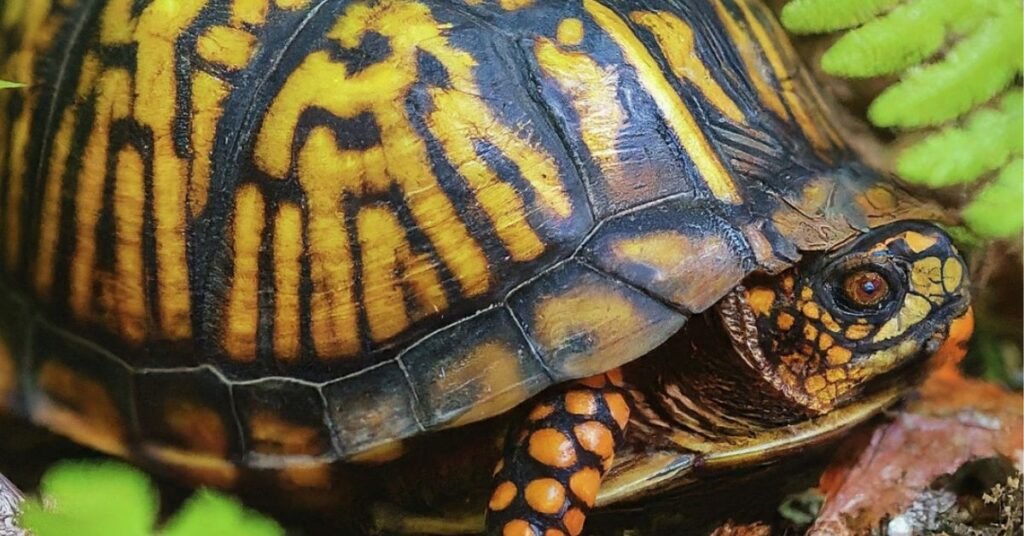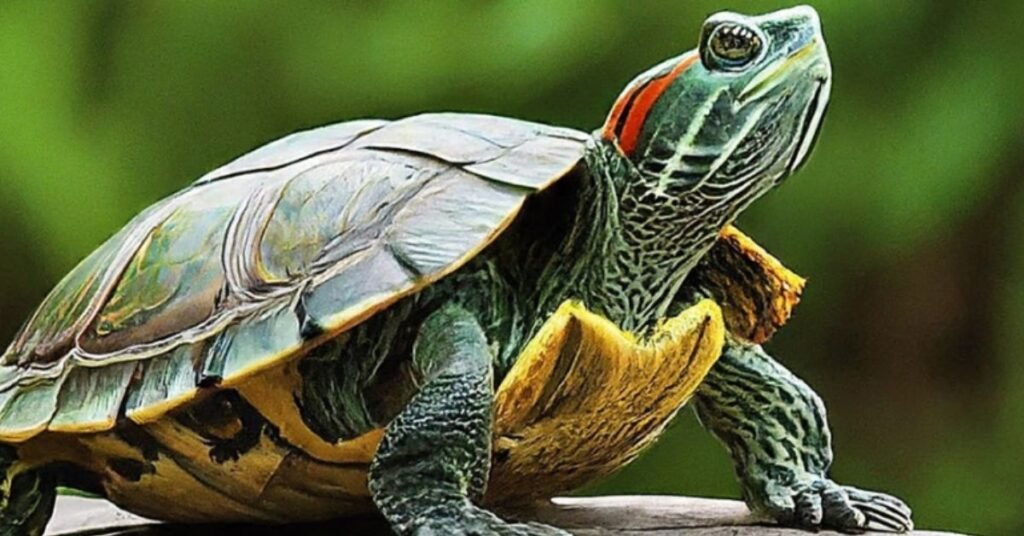Turtles are among the oldest animals on Earth, having existed for at least 200 million years. As such, they have adapted to many changes over time. We humans are warm-blooded, but what about turtles? Are turtles cold-blooded or warm-blooded like us?
One more interesting fact is that turtles are cold-blooded animals. Why so? The answer is simple—when their body temperature is low, turtles can’t move. If it is very high, the turtles may die. Since turtles have ancient lines and diverse habitats, they rely on external heat sources to regulate their body temperature. Today, we will go through this topic in depth.
Table of Contents
Are Turtles Cold Blooded?

Yes, turtles are cold-blooded reptiles or ectothermic animals. To control their body temperature, turtles have special lobes inside their bodies. This system allows turtles to tolerate temperatures between 4 and 10 degrees Celsius above the environment. Because of this, turtles regulate their surroundings’ temperature using their mouths and skin.
What Does It Mean to Be Cold-Blooded?
Known scientifically as ectotherms, these cold-blooded creatures rely on external heat sources to regulate their body temperature. Let’s delve into what it means to be cold-blooded and the differences between ectothermic and endothermic animals.
What Is Ectothermy
Ectothermy is when animals rely on the environment to manage body temperature. Ectothermic animals are called ectotherms. They don’t generate heat internally. Instead, they absorb heat from their surroundings. Common ectotherms include reptiles, amphibians, fish, and invertebrates. For example, snakes, frogs, and lizards are ectotherms. They often bask in the sun to warm up. Ectotherms are more active in warm conditions.
What Is Endothermy
Endothermy is the ability to regulate body temperature internally. Examples of endothermic animals include mammals and birds. They maintain constant body temperatures. Their high metabolism helps generate heat, which requires more food. Insulating features like fur and feathers help retain heat. Endotherms can live in varied climates and thrive in both cold and hot environments.
Ectothermic vs. Endothermic Animals
| Aspect | Ectothermic Animals | Endothermic Animals |
| Heat Regulation | Depend on external sources like the sun, water, or ground for heat | Generate heat internally through metabolic processes |
| Metabolism | Lower metabolic rates that fluctuate with environmental temperature | Maintain a constant body temperature, requiring high metabolic rates |
| Energy Use | More energy-efficient, requiring less food | Higher energy requirements need more food |
| Behavioral Adaptations | Exhibit behaviors like sunbathing and seeking shade to regulate body temperature | Not applicable; rely on physiological adaptations |
| Physiological Adaptations | Generally lack insulating features; rely on external heat sources | Have insulating features like fur, feathers, and fat to retain body heat |
How Ectothermic Turtles Rely on External Heat Sources

Ectothermic animals like turtles’ dependence on external temperatures have evolved various strategies like busking, borrowing, etc:
- Basking: Many reptiles, such as snakes and lizards, bask in the sun to raise their body temperature. This behavior is essential for digestion and overall metabolic function.
- Burrowing: Some ectotherms burrow into the ground or hide under rocks to avoid extreme temperatures. Amphibians, like frogs, often use this strategy to stay calm and moist.
- Color Change: Certain ectotherms can change their color to either absorb more heat or reflect it. For instance, the chameleon can darken its skin to soak up heat or lighten it to stay calm.
- Seasonal Adaptations: Some ectotherms enter a state of dormancy during unfavorable conditions. For example, many fish species slow their metabolism during winter to conserve energy.
How Turtles Control Their Body Heat (Thermoregulation )
Turtles require an external medium to heat their body. Here’s a brief look at their critical behavioral and physiological adaptations.
Behavioral Thermoregulation
- Basking in the Sun: Turtles, like the red-eared slider, often bask on logs or rocks to absorb heat. This heat can raise their body temperature by up to 10°C (18°F) above the ambient temperature.
- Seeking Shade or Water: To cool down, turtles seek shade or dive into water. This is how aquatic turtles, like the painted turtle, stay calm in water, which is up to 20°C (36°F) cooler than air.
- Burrowing and Hiding: Turtles like the Gopher Tortoise dig burrows up to 10 feet deep. They take a shelter that is 10-15°C (18-27°F) cooler than the surface.
Physiological Adaptations
- Shell as an Insulator: Turtles shell acts as an insulator. It can reduce heat loss by up to 50% and provide a buffer against rapid temperature changes.
- Countercurrent Heat Exchange: This system conserves heat by transferring warmth between blood vessels. It retains up to 80% of the heat that would otherwise be lost, helping keep the body warm.
- Vasoconstriction: Turtles narrow their blood vessels to reduce blood flow to the skin. This process can conserve core heat and reduce heat loss by up to 30%.
How Turtles Stay Warm

Now let’s see how temperature regulation works in different turtles:
Aquatic Turtles
Aquatic turtles, like the painted turtle, bask on logs or rocks. They absorb sun heat, raising their body temperature by ten °C (18°F). To cool down, they retreat into the water, which is up to 20°C (36°F) cooler than the air.
Terrestrial Turtles
Terrestrial turtles, such as the eastern box turtle, move between sunlit and shaded areas. They bask in the sun to warm up. To avoid overheating, they seek shade or burrow into the ground. Box turtles, for example, choose shaded habitats to match their body temperature with cooler environments.
Sea Turtles
Leatherback sea turtles use their large size, insulating fat, and countercurrent heat exchange to maintain body temperatures up to 18.2°C (32°F) higher than the surrounding water. In subpolar waters, leatherbacks have been observed maintaining a thermal gradient of up to 2.3°C in cold water of 16°C. This enables them to dive to depths of up to 1,200 meters (3,937 feet) without losing significant body heat.
Freshwater Turtles
Freshwater turtles, like the snapping turtle, exhibit both behavioral and physiological thermoregulation. For example, they bask to raise their body temperature but can also use vasoconstriction to retain heat during cooler periods. Due to their ability to switch between strategies, they are highly adaptable in various environments.
How Turtles Survive In Cold Climate
Turtles can survive harsh winter conditions because of their cold-blooded nature.
Brumation & Comparison to Hibernation
Brumation is a state of dormancy in reptiles and amphibians. During brumation, turtles slow their metabolism, heart rate, and activity to survive cold periods. Depending on the species and environment, turtles can be in brumation for several months (up to six months).
Hibernation is a deep sleep state common in mammals. During winter, mammals slow their metabolism and reduce body temperature to conserve energy.
Brumation is often compared or named as hibernation for turtles, but there’s a fundamental difference. While hibernation is common among mammals, brumation is a specific state for reptiles and amphibians.
Physiological Changes During Brumation
- Slowed Metabolism: Turtles’ metabolic rate decreases drastically, reducing their energy needs.
- Reduced Heart Rate: Their heart rate can drop to as low as one beat every few minutes.
- Behavioral Adaptations: Turtles often burrow into mud or bury themselves to avoid freezing temperatures.
For example, painted turtles can survive just above freezing for up to four months by lowering their body temperature. During sleep, their heart rate and metabolism slow down, so they use less energy.
Biochemical Adaptations: Nature’s Antifreeze
Turtles undergo biochemical changes to prevent their blood from freezing. Their blood chemistry shifts to keep their bodily fluids from crystallizing in subzero temperatures.
Glycogen Storage
Glycogen stored in the turtle liver provides a crucial energy reserve during brumation. When oxygen levels drop, turtles switch to anaerobic respiration, which uses these glycogen stores. However, this process produces lactic acid, which can be harmful in large amounts.
Carbonate Buffers
To counteract the buildup of lactic acid, turtles rely on their shells and bones, which release carbonate buffers. These buffers neutralize the acid, preventing damage to their tissues.
Evolutionary Advantages of Ectothermy in Turtles
As we have already told several times, turtles have undergone many adaptations over a million years. Today’s ectothermic feature is also a part of many adaptations. So how does this adaption benefit them? Let’s see –
Lower Metabolic Costs
Turtles rely on sunlight to regulate their body temperature. This lowers their metabolic rates compared to warm-blooded animals. They need less food to sustain energy. During brumation, a turtle’s metabolic rate can drop by 90%, which allows survival on minimal energy for months.
Lower metabolic demands mean turtles endure longer without food. This is a must during food scarcity. Painted turtles can survive underwater for four months in winter using stored energy and anaerobic respiration.
Adaptability to Extreme Environments
Ectothermy helps turtles adapt to various habitats, from deserts to cold waters. They regulate body temperature by basking in or seeking shade, which makes them highly adaptable.
Eastern box turtles burrow into the soil and brumate to survive freezing temperatures. A leatherback sea turtle thrives in cold waters because of its size and insulating fat, which keeps its inside temperature higher than that of the water.
Biochemical Strategies to Combat Temperature Extremes
Turtles produce heat-shock proteins during heat to protect against damage. In cold environments, they alter their body chemistry to prevent ice formation. They produce cryoprotectants like glycerol to safeguard cells and tissues.
FAQs
Are turtles cold-blooded animals?
Yes, turtles are cold-blooded animals. This means they rely on external heat sources to regulate their body temperature.
Are sea turtles cold-blooded?
Indeed, sea turtles are cold-blooded. They depend on their environment to maintain body warmth.
Are turtles warm or cold-blooded?
Turtles are cold-blooded. They use external sources like sunlight to control their body temperature.
Are box turtles cold-blooded?
Absolutely, like any other turtle, box turtles are cold-blooded and rely on external heat to stay warm.
Are green sea turtles cold-blooded?
Green sea turtles are cold-blooded, needing external heat to regulate their body temperature.
Are leatherback sea turtles cold-blooded?
Leatherback sea turtles are cold-blooded. For survival, their large size and fat layers help them stay warm in cold waters.
Read More: How Do Turtles Mate?
Wrapping Up
Turtles are masters of adaptation. Unlike us, they can’t control their body temperature. Instead, they rely on their surroundings, basking in the sun when it’s cold and seeking shade when it’s hot. It’s a clever way to survive in different environments. If anyone asks you, we hope now you know the answer to this question: “Are turtles cold-blooded?”
